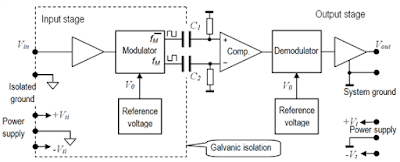Isolation amplifiers are used to provide electrical isolation and an electric safety barrier to the patients during measurements. Some patients are highly susceptible to electrical shock hazards. Under certain conditions, these shock hazards can cause very severe effects to the patient. So it is required to protect the patient. The isolation amplifiers can provide very high insulation in the range of about a lack mega ohms! There exist a common mode voltage which are the potential difference between instrument ground and signal ground during measurement. The data acquisition components need to be protected from this common mode voltages because as the magnitude of it increases, the chance of instrument destruction increases. Even if the magnitude of the common mode voltage is low, there is a possibility of noisy representation of the signal under investigation.
Isolation amplifiers are very useful when we need to amplify low level signals in multichannel applications. Also they eliminate measurement errors caused by ground loops.
There are two broad classifications of isolation amplifiers. Some isolation amplifiers provide input-to-output isolation without channel-to-channel isolation. It offers only one isolation barrier for a multichannel instrument. Some other type of isolation amplifiers provide both input-to-output isolation and channel-to-channel isolation.
There are two isolation amplifier specifications.
1. The amplifier isolation breakdown voltage: It is defined as the absolute maximum common mode voltage that the isolation amplifier can handle without damage.
2. The Amplifier CMRR: It is defined as the degree to which the common mode voltage will disrupt the normal mode component measurement.
In addition to these, the frequency of the common mode voltage is also important. Higher frequency common mode voltages can create difficulty for many isolation amplifiers due to the effect of parasitic capacitance.
The basic block in figure which illustrate the working of an isolation amplifier is shown below.
Input amplifier amplifies the input and the amplified output is applied to a modulatior which modulates the signal by using AM, PWM or any other technique. The isolation barrier is generally an energy converter where the electrical energy of the modulator is converted to some other form of energy (a non-electrical energy). Then the signal is modulated and finally amplified by the output amplifier.
The standard symbol of an isolation amplifier is shown in figure.
Isolation amplifiers are very useful when we need to amplify low level signals in multichannel applications. Also they eliminate measurement errors caused by ground loops.
There are two broad classifications of isolation amplifiers. Some isolation amplifiers provide input-to-output isolation without channel-to-channel isolation. It offers only one isolation barrier for a multichannel instrument. Some other type of isolation amplifiers provide both input-to-output isolation and channel-to-channel isolation.
There are two isolation amplifier specifications.
1. The amplifier isolation breakdown voltage: It is defined as the absolute maximum common mode voltage that the isolation amplifier can handle without damage.
2. The Amplifier CMRR: It is defined as the degree to which the common mode voltage will disrupt the normal mode component measurement.
In addition to these, the frequency of the common mode voltage is also important. Higher frequency common mode voltages can create difficulty for many isolation amplifiers due to the effect of parasitic capacitance.
The basic block in figure which illustrate the working of an isolation amplifier is shown below.
Input amplifier amplifies the input and the amplified output is applied to a modulatior which modulates the signal by using AM, PWM or any other technique. The isolation barrier is generally an energy converter where the electrical energy of the modulator is converted to some other form of energy (a non-electrical energy). Then the signal is modulated and finally amplified by the output amplifier.
The standard symbol of an isolation amplifier is shown in figure.



Hello
ReplyDeleteDo isolated amplifier amplifies the input signal??